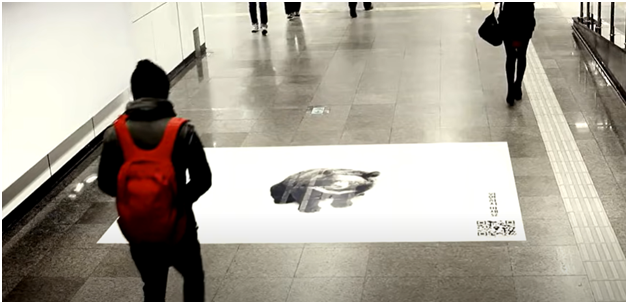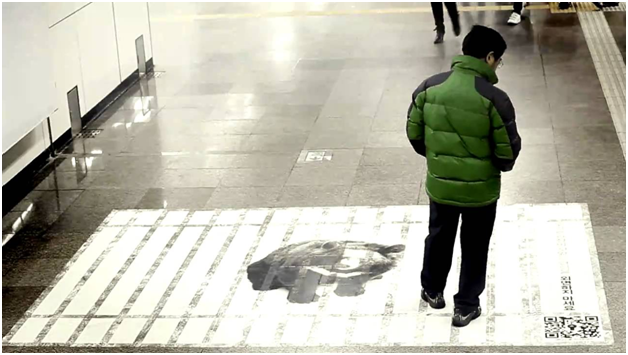Check out how this campaign exposed the unBEARable realities of an illegal market in South Korea! [Thursdays: Gorillas of Guerrilla Marketing]

Miles Everson’s Business Builder Daily speaks to the heart of what great marketers, business leaders, and other professionals need to succeed in advertising, communications, managing their investments, career strategy, and more.
A Note from Miles Everson:
I believe one of the best ways to effectively raise awareness about your brand and connect with your target audience is by generating a good kind of buzz.
As business owners, leaders, and marketers, you should always aim for good marketing—marketing that helps produce positive results for your brand, whether that be in terms of increasing brand awareness, boosting sales, improving engagement rates, etc.
One of the marketing strategies you can use to achieve that?
Guerrilla Marketing!
Read the article below to know how one museum in South Korea cleverly used a poster to communicate its message about the illicit industry of Bear Bile Farming.
Miles Everson
CEO, MBO Partners
Chairman of the Advisory Board, The I Institute
Gorillas of Guerrilla Marketing
Bears are carnivoran mammals that live in a wide variety of habitats throughout North America, South America, Europe, and Asia.
Since prehistoric times, these animals have been hunted for their meat and fur, and they have also been used for bear-baiting and other forms of entertainment.
In modern times, bears are faced with even more dangers―from encroachment on their natural habitats to illegal trading of bear parts.
An example of this is the Asian bear bile market―a practice in which bears are kept in captivity to harvest their bile, a digestive fluid produced by the liver and stored in the gallbladder. The bear bile is commonly used in China and South Korea as a traditional medicine.
So, in 2010, one South Korean museum created an impactful guerrilla marketing campaign to open the minds of the public and encourage them to not turn a blind eye on this illegal practice.
That museum is…
The Teddy Bear Museum!

In South Korea, over 1,000 bears were kept in small and dirty cages for the purpose of harvesting their bile and selling it as a traditional Asian medicine. The main reason why illegal “bear bile farming” went on for many years was because a lot of South Koreans didn’t know about it or were apathetic towards it.
As a family-friendly locale that advocates for the freedom and happiness of bears, the Teddy Bear Museum launched a guerrilla marketing campaign in 2010 called…
The “Footprint Poster” campaign!
The aim of this campaign was to make the public realize how much influence their indifference had on bears.
Here’s how the campaign team executed this guerrilla marketing stunt:
The Teddy Bear Museum partnered with creative agency SwanSong to place a transparent adhesive poster of a Moon Bear on the floor of a busy South Korean subway station.

Every time commuters walked across the poster’s white background, the dirt from their shoes stuck to the adhesive, gradually creating the image of cage bars around the bear.

The initial caption on the poster read, “Don’t turn away…” However, as more commuters walked on it, an underlying message―“… what your indifference trampled.”―was revealed.
This message made passersby realize the consequences of their own indifference not only to the image but also to the harsh realities of the bear bile farming industry.
There was also a large QR code on the lower right corner of the poster. Scanning it using a smartphone directed commuters to an online petition against the continuation of bear bile farming in South Korea.

At the center of the QR code was a key. This implied that people’s actions of signing the petition are keys to setting the bears free.
Using a time-lapsed hidden camera, the “Footprint Poster” campaign was recorded and posted on YouTube for the global online audience to see.
Was the Teddy Bear Museum’s “Footprint Poster” campaign effective?
The campaign’s message was simple and clear. The image of the Moon Bear and the tagline were emotive and the gradual revelation of the message through commuters’ footprints captured people’s attention not only in South Korea but also in other countries.
Below are the results of the “Footprint Poster” campaign:
- In just a week, the uploaded video on YouTube had over 4 million views, 81,000 likes, and 2,000+ comments.
- During the duration of the campaign, more than 410,000 commuters walked on the poster. Over 67,000 of them scanned the QR code and signed the petition.
- By posting the time-lapsed video of the campaign on YouTube, the petition also gained immense support from western societies and media outlets such as the National Geographic and the Daily Mail UK. Both companies proceeded to carry out investigations into the practice.
- Through the “Footprint Poster” campaign, the Teddy Bear Museum transcended its geographical boundaries and became a well-known organization with a universal call-to-action for animal rights.
There’s more!
On February 1, 2022, South Korea announced a ban on taking bile from live bears. The country’s Environment Ministry officially signed agreements with the Bear Farmers Association and other animal protection groups that have long been pushing for an end to the bear bile industry for decades.
Finally, freedom for the bears!
While the campaign happened 12 years before the ban was set, it was probably one of the contributing factors that spread awareness and why South Korea made a move to stop the illegal practice.
Congratulations to the Teddy Bear Museum and SwanSong for this meaningful campaign!
One of the most important aspects of the “Footprint Poster” campaign was the difference in perception based on geographic and cultural contexts. When the guerrilla marketing tactic was launched, it only intended to target the South Koreans on their apathy towards the extraction of bear bile.
However, through the digital avenues of cultural “clicktivism,” the Teddy Bear Museum’s civic campaign went global.
As a business owner or marketer, what can you learn from this guerrilla marketing tactic?
First, simplicity is key. The less complicated your marketing campaign is, the easier it will be for your target audience to interact with it.
Take for example the “Footprint Poster” campaign. It’s simple to the point that passersby didn’t even know they’re taking part in the gradual reinforcement of the Teddy Bear Museum’s message. However, as the cage bars and tagline became clearer, people started to make sense of it.
Not just that!
The emotional aspect of the poster―seeing the Moon Bear behind bars―also contributed to its global virality.
Second, take advantage of the continuing rise of guerrilla marketing gimmicks and media convergence. With these things, you’ll effectively use the Internet to influence the public’s worldviews on social and environmental justice.
We hope you find this guerrilla marketing example insightful!
With a carefully planned-out strategy, you’ll come up with and execute an out-of-the-box campaign that your target market will appreciate and enjoy.
(This article is from The Business Builder Daily, a newsletter by The I Institute in collaboration with MBO Partners.)
About The Dynamic Marketing Communiqué’s
“Thursdays: Gorillas of Guerrilla Marketing”
Jay Conrad Levinson (1984) said that Guerrilla Marketing “works because it’s simple to appreciate, easy to execute, and inexpensive.”
Guerrilla Marketing is unconventional.
Looking beyond the traditional ways of advertising, marketers, and advertisers need to spice things up in order for their brand to have campaigns that not only make an impact but also stick to their target market’s mind.
Guerrilla Marketing usually aims to have direct contact with consumers.
This type of direct contact should spark an emotional reaction that leads to consumers effectively remembering the brand.
It’s about making a big impression and making that impression last a long time (if not forever).
Guerrilla Marketing can be inexpensive.
The effect of this is being able to create a buzz around the brand, and the strategy used to market it. Almost everything is passed around through word-of-mouth.
Word-of-mouth is one of the greatest outcomes and it usually doesn’t cost anything.
This is every business’ or brand’s dream!
Every Thursday, we publish tips, examples, and other useful content on unconventional ways of marketing and promotion.
Learn more about how to grab your target market’s attention and make an amazing first and lasting impression without having to spend a lot of money.
Businesses don’t really need to spend much for a guerrilla campaign. You do not need a big budget to be successful. You just need creativity and a good imagination.
Hope you’ve found this week’s guerrilla marketing insight interesting and helpful.
Stay tuned for next Thursday’s Gorillas of Guerrilla Marketing!
Cheers,
Kyle Yu
Head of Marketing
Valens Dynamic Marketing Capabilities
Powered by Valens Research
www.valens-research.com




